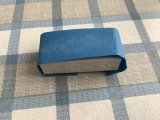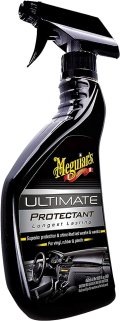This post has been a long time coming, as I’ve been figuring out the best method for over a decade LOL. Some new products have become available during that time, and I finally feel like I have found a way that’s good and easy enough to publish.
BG chips are made of a softer plastic, but they also have a hard surface finish, which makes them slick. Once that hard finish wears off, they feel very much like Abbiati chips do straight out of the box. Here are very used BG chips with decals removed that I have cleaned, the treated ones started out in the same condition as the untreated ones. The surface stays soft to the touch, but the looks are much improved. The rolling edge will also feel soft after this treatment.


(1) Sanding the rolling edge
You want to have a flat surface that you can run along the rolling edge to keep it from getting rounded. I made a miniature sanding block from an eraser, but anything that’s comfortable to hold should work fine.

If the rolling edge looks ragged like on these chips, I’d recommend starting with 2500 grit until the grooves are gone, followed by 5k, 7k and 10k grits. Use water with all of them. You can spend extra time with the 10k. I gave the bevel also a quick polish using only the 10k (again to avoid rounding the rolling edge any further).
(2) Sanding the chip face
Here you want a flat surface also. I put a soft towel on a table and placed a sheet of glass over that. Then I placed 5k, 7k and 10k grits on the glass. Using water I placed a chip on the lowest grit and moved it around in a circular motion with very little pressure. Rinsed the chip and repeated on the next grit until done, again you can spend extra time with the final grit.
(3) Color out of space
The chip should already look much better than at the beginning, but to really bring back vivid colors I have used Meguiar’s Ultimate Protectant for vinyl, rubber and plastic.

Using protective gloves I applied a tiny amount in a well ventilated area, rubbing it all over the plastic. If there’s excess, wipe it off and let it cure (my chip was on a towel so I turned it around occasionally, softly wiping the chip to remove any excess that may have been left over from before).
(One small caveat is that unless the rolling edge is made smooth enough on soft plastic like this, it will dry over time. In the past I actually burnished the rolling edge, but I think the 10k grit finish should be smooth enough. Ask me in a few months to know for sure LOL.)
——————————
There you go! I hope this helps, feel free to post pics here if you try this on your chips, I’d love to see them.
BG chips are made of a softer plastic, but they also have a hard surface finish, which makes them slick. Once that hard finish wears off, they feel very much like Abbiati chips do straight out of the box. Here are very used BG chips with decals removed that I have cleaned, the treated ones started out in the same condition as the untreated ones. The surface stays soft to the touch, but the looks are much improved. The rolling edge will also feel soft after this treatment.
(1) Sanding the rolling edge
You want to have a flat surface that you can run along the rolling edge to keep it from getting rounded. I made a miniature sanding block from an eraser, but anything that’s comfortable to hold should work fine.

If the rolling edge looks ragged like on these chips, I’d recommend starting with 2500 grit until the grooves are gone, followed by 5k, 7k and 10k grits. Use water with all of them. You can spend extra time with the 10k. I gave the bevel also a quick polish using only the 10k (again to avoid rounding the rolling edge any further).
(2) Sanding the chip face
Here you want a flat surface also. I put a soft towel on a table and placed a sheet of glass over that. Then I placed 5k, 7k and 10k grits on the glass. Using water I placed a chip on the lowest grit and moved it around in a circular motion with very little pressure. Rinsed the chip and repeated on the next grit until done, again you can spend extra time with the final grit.
(3) Color out of space
The chip should already look much better than at the beginning, but to really bring back vivid colors I have used Meguiar’s Ultimate Protectant for vinyl, rubber and plastic.

Using protective gloves I applied a tiny amount in a well ventilated area, rubbing it all over the plastic. If there’s excess, wipe it off and let it cure (my chip was on a towel so I turned it around occasionally, softly wiping the chip to remove any excess that may have been left over from before).
(One small caveat is that unless the rolling edge is made smooth enough on soft plastic like this, it will dry over time. In the past I actually burnished the rolling edge, but I think the 10k grit finish should be smooth enough. Ask me in a few months to know for sure LOL.)
——————————
There you go! I hope this helps, feel free to post pics here if you try this on your chips, I’d love to see them.
Last edited:
